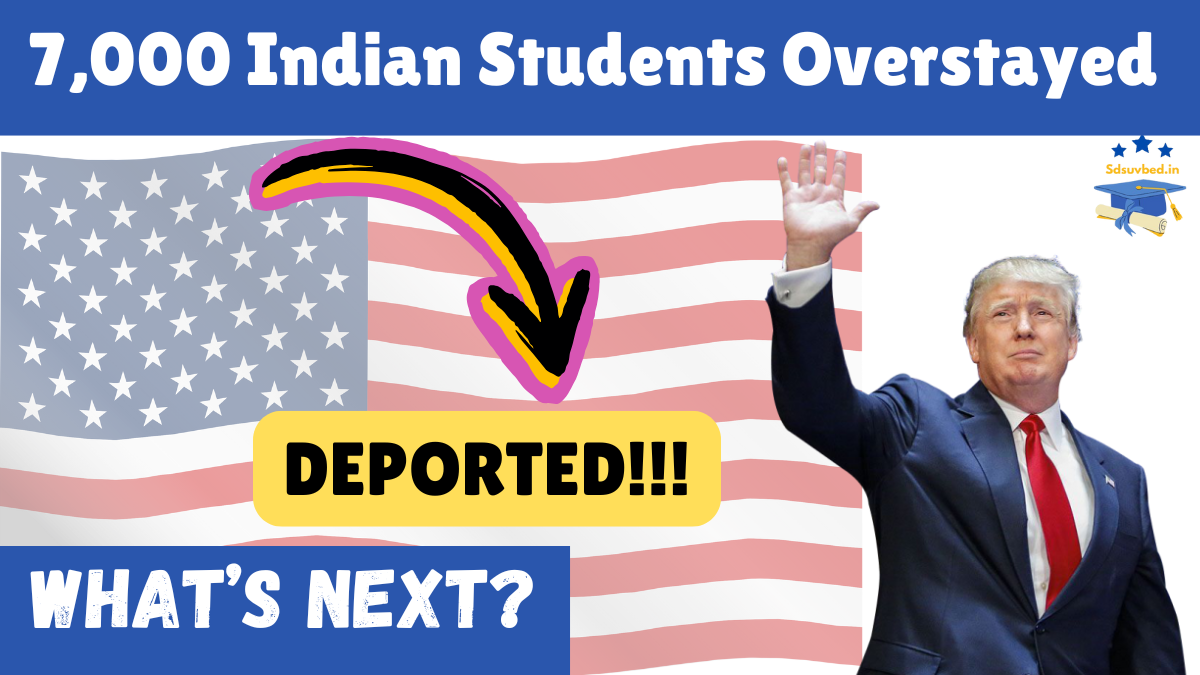The issue of student visa overstays in the United States has become a growing concern, with India leading the numbers in 2023. According to a report presented to US lawmakers, more than 7,000 Indian students and exchange visitors overstayed their visas last year, surpassing other countries like Brazil, China, and Colombia.
Jessica M. Vaughan, a policy expert from the Center for Immigration Studies, shared these statistics with the US House Committee on the Judiciary during a discussion on immigration enforcement. With student and exchange visitor overstay rates rising, policymakers are now pushing for significant visa reforms.

What Are the US Student Visa Overstay Rates?
Overstaying a visa means that a person remains in the country beyond the permitted duration of their stay. Reports indicate that the F and M visa categories—which allow international students to study in the US—have the highest overstay rates among all temporary admissions.
A closer look at student visa overstay rates reveals:
| Country | Overstaying Students in 2023 |
|---|---|
| India | 7,000 |
| China | 4,500 |
| Brazil | 3,000 |
| Colombia | 2,500 |
Additionally, 32 countries have student visa overstay rates exceeding 20%, signaling a widespread issue.
What Are F-1 and M-1 Visas?
The F-1 visa allows students to enter the US for full-time study at accredited institutions, including universities, colleges, and language training programs.
The M-1 visa, on the other hand, is issued for students enrolled in vocational and non-academic programs.
Since these visas come with a defined expiration period, failure to leave the country on time results in an “overstay” status, which can lead to serious legal consequences, including potential deportation and future visa restrictions.
Why Is India Leading in Student Visa Overstays?
The high number of overstays from India can be attributed to several factors:
- Better job opportunities in the US compared to India
- Lack of strict enforcement on visa expirations
- H-1B visa bottlenecks, leading students to overstay while seeking work
- High cost of returning home and difficulty in finding equivalent opportunities
- Uncertainty about immigration policies and delays in visa extensions
With these challenges in mind, lawmakers and experts are suggesting stricter enforcement and policy changes.
What Visa Reforms Are Being Proposed?
Jessica M. Vaughan suggested key changes to US immigration policies to prevent overstays and misuse of work visas. Some of her recommendations include:
- Eliminating “dual intent” for student visas – Every student visa applicant should prove that they plan to return home after their studies.
- Limiting H-1B visa duration – Currently issued for up to six years, Vaughan suggests reducing the period to two years, with a maximum extension of four years.
- Restricting Green Card extensions – There should be no automatic visa extensions based on a Green Card petition.
- Reducing the annual H-1B visa cap – Vaughan proposes limiting the number to 75,000 visas per year, down from the current 85,000 (excluding nonprofit and research sectors).
- Prioritizing higher-paying employers – If demand exceeds supply, visas should be given to employers offering the highest salaries to ensure only top talent is selected.
Does the US Have a Labor Shortage?
A key argument against issuing more work visas is that the US does not have a labor shortage. Vaughan pointed out that:
- Millions of American workers have dropped out of the workforce.
- In STEM fields, more than two million US graduates are unemployed or working outside their field.
- The H-1B program has been misused by staffing firms that replace American workers with cheaper foreign labor.
She suggests that US companies should be held accountable for high overstay rates among their sponsored employees.
How Will These Changes Impact Indian Students?
If these reforms are implemented, Indian students and workers in the US may face significant challenges, including:
- Stricter visa approval process
- Fewer work visa opportunities
- Shorter visa durations, requiring frequent renewals
- Higher competition for limited job openings
- Greater enforcement on overstaying cases, leading to possible deportations
For Indian students planning to study in the US, these potential changes highlight the importance of staying updated on immigration policies and complying with visa regulations to avoid long-term legal consequences.
FAQs
What happens if a student overstays their visa in the US?
Overstaying a visa can result in deportation, visa bans, and difficulty obtaining future US visas. It also affects employment opportunities and legal status.
Can Indian students apply for H-1B visas after graduation?
Yes, Indian students can apply for H-1B work visas after graduation, but they must be sponsored by an employer and go through the competitive selection process.
How does the US track student visa overstays?
The US Department of Homeland Security (DHS) monitors student visa holders through the Student and Exchange Visitor Information System (SEVIS), tracking entry and exit records.
What are the consequences of a high overstay rate for Indian students?
A high overstay rate can lead to stricter visa policies, longer approval wait times, and increased scrutiny for Indian applicants.
Will the proposed H-1B visa changes affect Indian workers?
Yes, the proposed changes could reduce H-1B visa availability, limit stay durations, and prioritize high-paying employers, making it harder for Indian workers to secure long-term jobs.
Why is the US government tightening visa regulations?
Due to rising visa overstays and concerns over job displacement, the US is focusing on protecting American workers and reducing immigration loopholes.
Can visa overstayers fix their status in the US?
In some cases, overstayers may apply for waivers, asylum, or other immigration relief options, but most face serious legal challenges.
What should Indian students do to avoid overstaying their visas?
Students should track visa expiration dates, apply for extensions if needed, and explore legal work authorization options like OPT and H-1B.
Click here to know more.
A passionate content writer specializing in creating engaging, SEO-optimized content. With expertise in blogs, web copy, and storytelling, I craft words that connect with audiences and deliver results.
